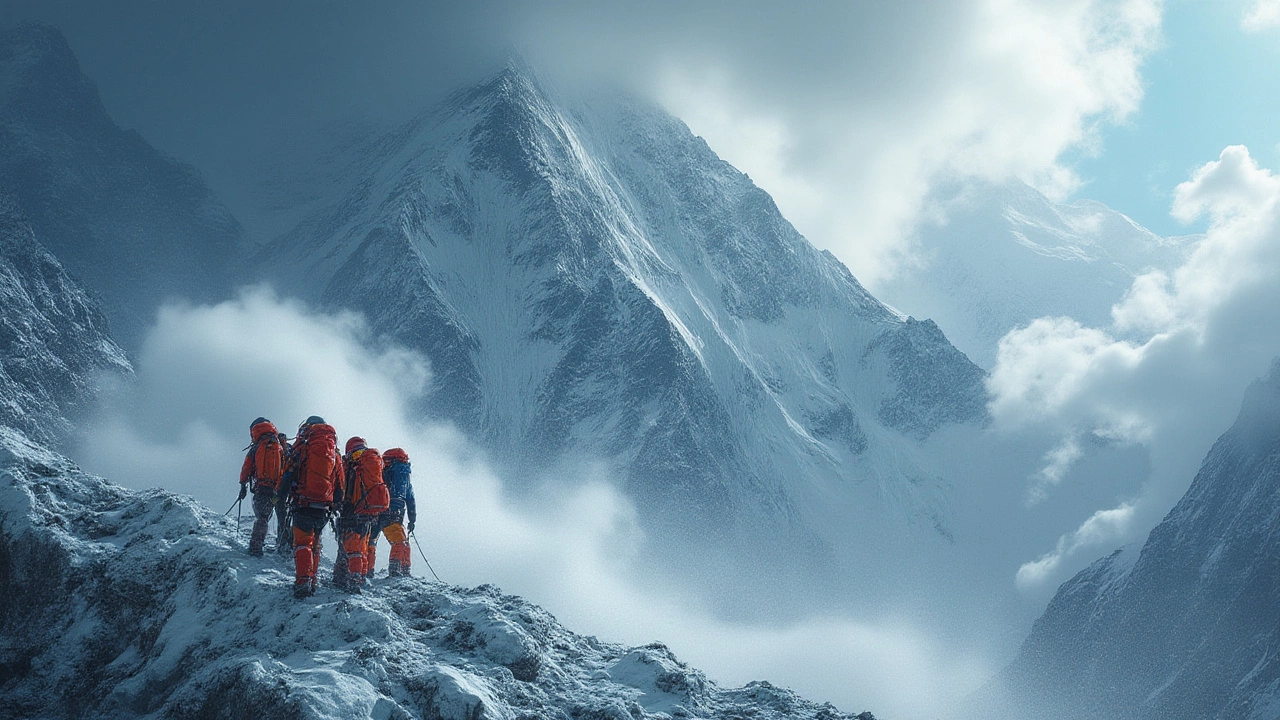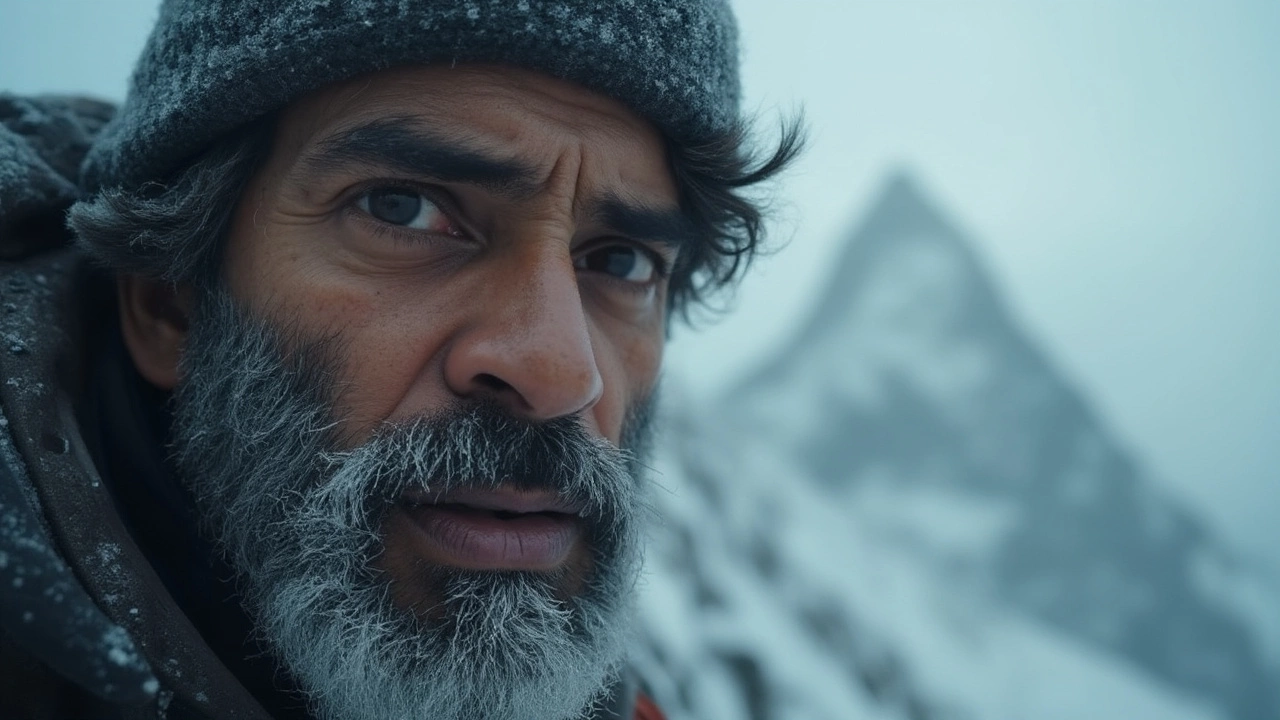Deadliest Mountain Climb: Ranking the Most Dangerous Ascents on Earth
 Jul, 23 2025
Jul, 23 2025
There’s a chilling fact mountain climbers know: success up high isn’t just about getting to the top—it's making it back down alive. Across the world, hardcore adventurers and dreamers chase the peaks that dominate history books for all the wrong reasons. Which mountain holds the title 'deadliest'? Shocking as it is, Everest is not even close to being the riskiest climb out there. There’s another peak notorious for swallowing climbers, trapping experienced guides, and forever changing the lives of those who challenge its slopes: Annapurna I. But death haunts other ranges too, from the snaking ridges of K2 to the avalanche traps of the Eiger. So what makes a climb truly deadly? And what are the stories, numbers, and realities that keep seasoned mountaineers awake at night?
Where Death Lurks: Defining the Deadliest Climbs
When people talk about 'deadly' mountains, they tend to focus on Mount Everest—it gets the press, the Instagram shots, and a steady stream of adventure documentaries. But if you’re asking the pros or if you dig up the real stats, Everest isn’t the most dangerous. That dubious distinction goes to other giants, thanks to a statistic that matters most: the fatality rate. This is not just about total deaths; it’s about your odds of dying compared to those who actually try to reach the top. So, while many more people have died, say, on Everest (over 330 as of 2023), far more have actually summited. Your chances are much worse on Annapurna I in Nepal, a hulking 8,091-meter beast that tempts only the bravest or perhaps the most reckless.
Here’s what sets Annapurna I apart: for every three climbers who have tried to summit, one has died. That’s a staggering fatality rate, which hovered around 32% for decades, dropping a bit recently with better gear and aggression from rescue teams. For context, Everest’s current fatality rate as of 2024 is closer to 1%. K2, standing proudly in the Karakoram, also brings nightmares to the mountaineering world, often called the ‘Savage Mountain.’ Its fatality rate loiters at about 25%, still no joke. Other infamous spots line up: the Eiger's North Face in Switzerland, Nanga Parbat (or the 'Killer Mountain') in Pakistan, the unpredictable Kangchenjunga on the Nepal-India border. They're all sobering.
Why are these mountains more dangerous than Everest? For starters, climbers on Annapurna and K2 have to deal with unpredictable weather, avalanches so violent that they erase tracks and hope, technical sections so steep one wrong move is usually fatal, and rescue is nearly impossible when things go south. This isn’t just about height; it’s about fierce geography, volatile weather, and a terrifying lack of safety nets. Annapurna is infamous because of its massively unstable snowfields and the risk of slab avalanches just beneath the summit’s ice cap. Many climbers have died not while pushing to the top, but while descending, exhausted and battered by thinning air and killer storms rolling in without warning. Check the table below to see just how grim these numbers are.
| Mountain | Country | Height (m) | Successful Ascents | Reported Deaths | Fatality Rate (%) |
|---|---|---|---|---|---|
| Annapurna I | Nepal | 8,091 | 365 | 73 | 20 |
| K2 | Pakistan/China | 8,611 | 377 | 92 | 24 |
| Kangchenjunga | Nepal/India | 8,586 | 379 | 58 | 15 |
| Nanga Parbat | Pakistan | 8,126 | 335 | 69 | 20 |
| Mount Everest | Nepal/China | 8,848 | 6,338 | 335 | 1 |
Numbers alone don’t tell the whole story. But they should give pause to anyone assuming summiting just means fighting altitude. Annapurna’s record is especially notorious. That’s the mountain with legends of entire expeditions being buried, and climbers crossing avalanche tracks, knowing they’re rolling dice with fate.
Annapurna I: Anatomy of a Killer Mountain
There’s something almost mythic about Annapurna I. It was the first 8,000-meter peak ever climbed, back in 1950, by Maurice Herzog's French team. But the celebrations were grim: frostbite cost Herzog all his fingers and toes, several others had amputations, and the route has rarely been repeated. Ask any modern climber, and even with the latest equipment—weather alerts, lighter oxygen tanks, better nutrition—the sense of danger is everywhere.
Why is Annapurna I so vicious? The south face is one of the steepest vertical climbs among the world’s big peaks. It’s nearly 3,000 meters of sheer wall with hanging glaciers that crack and break at random, throwing ice and rock debris down every hour. Add in corniced ridges, deep crevasses, and “objective hazards” that can’t be outsmarted or avoided. It’s like Russian roulette with avalanches, especially in the spring.
Climbers know that the snow conditions can flip from safe to suicidal overnight. Two weeks of good weather, and suddenly a live-time storm clogs the escape route. Sometimes, there’s news that no one wants to hear—like in 2014 when 43 trekkers died in a freak blizzard on the Annapurna Circuit. This wasn’t even on the main summit line! Guides talk about the “lottery of timing.” Hit the right window, and you might make it. Miss it by a day, and your chances drop to zero. Even on a perfect day, lurking under that peaceful blanket of snow is a slab waiting to cut loose and sweep climbers off without warning.
What’s eerie is how many of the world’s best have met their end here. Legendary Spanish climber Iñaki Ochoa de Olza died on Annapurna in 2008, despite a massive international effort to save him. Polish alpinists, renowned for their toughness, have fallen prey to the mountain’s traps. Sara Hueniken, a top Canadian alpinist from Canmore, has publicly said it’s the one big peak she’ll never even dream of laying boots on, calling it “a mountain that scares even the fearless.” The lesson? Sometimes skill, fitness, and boldness are not enough. Annapurna is the perfect storm of altitude, exposure, and chance—just about the worst odds you could ask for.

K2, Eiger, and Other Deadly Giants: Twisted Tales From the Summits
K2 gets a lot of attention for good reason. At 8,611 meters, it’s the world’s second-highest mountain, but far more demanding than Everest. The routes aren't technically harder per se, but the overall margin for error is much smaller—the ascent is more exposed, rescue options near zero, and the weather, especially on the upper slopes, is famous for snuffing out hope without warning. Storms materialize seemingly out of thin air in the Karakoram, winds can hit 100mph, and temperatures plummet well past minus 40. One false step in the Bottleneck, a narrow couloir lined with unstable ice seracs near the summit, and you’re gone. The death toll in 2008 shocked the world when 11 climbers died in a single storm—either struck by falling ice or trapped and succumbing to the cold. No one forgets the accounts of exhausted mountaineers passing bodies still clipped to fixed lines, a constant reminder that mistakes are rarely forgiven here.
The Eiger, on the other hand, is much lower—just 3,967 meters. But don’t let that fool you. Its North Face, nicknamed the “Mordwand” or “Murder Wall,” has killed over 60 climbers since it was first attempted in the 1930s. This wall is nearly a mile of dark limestone, often slick with ice and battered by rockfall, storms, and a chilling history that reads like a true crime novel. The challenge here isn't just the cold or the climbing skill—it's about keeping your head when things go horribly sideways, like when a dodgy anchor peers out at you and a storm is rolling in faster than you can rappel. The stories from the Eiger are legendary for a reason: failed rescues, heroic last stands, and haunting tales of climbers writing goodbye letters on snow-stained bivouacs. That psychological weight, plus technical nastiness, gives this climb a fittingly deadly reputation.
Other mountains round out the rogues’ gallery. Kangchenjunga holds the tragic honor of the deadliest mountain in Nepal after Annapurna, with most of the deaths on descent—the treacherous return journey. Nanga Parbat, the “Killer Mountain,” was so infamous that it resisted the first successful climb until the 1950s, years after several doomed Nazi-led attempts ended in avalanches, falls, or exposure. The stats still chill the blood: a fatality rate of about 20%, many skilled alpinists lost. Taken together, these mountains teach a harsh lesson—size isn’t everything. Bad weather, unstable terrain, and psychological stress can turn even a seemingly ‘smaller’ climb into a killer.
Staying Alive: Tips, Tech, and Madness in High-Altitude Climbing
Why do people keep coming back to these deadly heights? It's a mix of adventure, ego, and, if we're being honest, a little bit of madness. There’s no guarantee of coming back. But there are ways to stack the odds in your favor. Preparation is everything. Years of specialized training, living at altitude, and practicing rescues in the worst-case scenarios are standard. Most successful climbers on Annapurna, K2, or Nanga Parbat have at least five or six other major peaks under their belt first. Fitness alone isn’t enough unless paired with cold judgment and mountain smarts.
Tech helps. Modern sat phones, GPS trackers, and weather models give climbers a fighting chance at picking the right summit window and calling for help if things go bad. Ultralight tents, double-insulated down suits, and oxygen rigs are much better now than when Herzog shivered on Annapurna in the ‘50s. But gear has limits—technology can’t stop an avalanche or fix your frostbitten hands. You need solid logistics, a weather-savvy team manager, and backup plans for backup plans. Many expeditions hinge on hiring Nepalese Sherpas and Pakistani high-altitude porters—without their skill, no one would stand a chance on half these routes.
There are ways to make deadly climbs a little less lethal. Here are some practical survival tips:
- Never gamble with the weather. If a forecast looks even slightly sketchy, bail. No summit is worth your life.
- Listen to the locals—guides and Sherpas have generations of knowledge. If they’re uncomfortable, take it seriously.
- Always set a hard turnaround time. If you’re not on your descent by then, you go down—no matter how close you are to the top.
- Keep a reserve of energy and supplies for emergencies. Most deaths happen on the way down, when people are exhausted.
- Don’t push solo. Climbing with at least one experienced partner saves lives—sometimes quite literally pulling you out from disaster.
Experience is everything, but humility is more important. Countless climbers who didn’t make it back ignored warning signs or pushed their limits too far. The deadliest climbs don’t care if you’re strong or determined; they punish overconfidence and reward discipline. The real ‘win’ often isn’t the view from the summit—it’s the quiet relief of reaching base camp, sharing a meal, and knowing you lived to tell the tale.
So, when people ask what is the deadliest climb in the world, most experts say Annapurna I—by the hard numbers, by reputation, by the stories people trade over cups of tea in Katmandu hostels. Maybe the most important lesson is this: mountains don’t kill people. Bad decisions, bad luck, and sometimes, the sheer indifference of nature do. If you’re thinking about tackling the deadliest climbs, remember—gravity never negotiates.